___________________
 Depending
on your orientation, the first sign that spring is in the air
usually catches the notice of
either the eye or the ear. Which means if you're the kind that
gets unwound by sound, you'll have already reserved seats for
Jazz
En Rafale, the first of Montreal's many jazzfests
that have turned the city into one of the world’s premier
jazz destinations.
Depending
on your orientation, the first sign that spring is in the air
usually catches the notice of
either the eye or the ear. Which means if you're the kind that
gets unwound by sound, you'll have already reserved seats for
Jazz
En Rafale, the first of Montreal's many jazzfests
that have turned the city into one of the world’s premier
jazz destinations.
Spearheaded
by Alain Bédard and Carole Therrien of the
Effendi label, the festival,
now in its 8th year, dedicates itself to keeping alive and well
the spirit of 'pure' jazz, featuring mostly home grown talent
and special guests such as Paul McCandless, who come from far
to play with the city’s best.
For the
younger musicians, the Jupiter-Vandoren Competition that is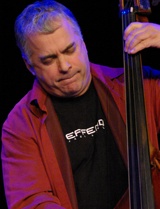 integrated into the overall program makes Jazz En Rafale the most
important festival of the year. Up and coming groups are invited
to submit their material after which five combos (trio, quartet
or quintet) are chosen to open up for the main act. The group
judged to be the best gets to record a debut album with Effendi,
so you can imagine the quality of original material and superb
playing and listening such an event inspires. And when you’re
young and impressionable, getting to rub shoulders live with those
you have admired at a distance is no small honour. It goes without
saying, the exposure is priceless for both musician and audience
since it is from their ranks we are introduced to the next generation
of jazz stars. This
year's selection set a precedent that will be difficult to better;
the top notch musicianship and sometimes madly inspired original
material belied the age of the performers. As far as my ear was
concerned, they all deserved a place on the podium, and in some
cases, depending on the kind of jazz you like, they were at least
equal to the main show.
integrated into the overall program makes Jazz En Rafale the most
important festival of the year. Up and coming groups are invited
to submit their material after which five combos (trio, quartet
or quintet) are chosen to open up for the main act. The group
judged to be the best gets to record a debut album with Effendi,
so you can imagine the quality of original material and superb
playing and listening such an event inspires. And when you’re
young and impressionable, getting to rub shoulders live with those
you have admired at a distance is no small honour. It goes without
saying, the exposure is priceless for both musician and audience
since it is from their ranks we are introduced to the next generation
of jazz stars. This
year's selection set a precedent that will be difficult to better;
the top notch musicianship and sometimes madly inspired original
material belied the age of the performers. As far as my ear was
concerned, they all deserved a place on the podium, and in some
cases, depending on the kind of jazz you like, they were at least
equal to the main show.
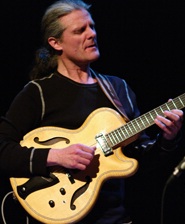 Prior
to the memorable, closing concert delivered by the magnificent
Prior
to the memorable, closing concert delivered by the magnificent
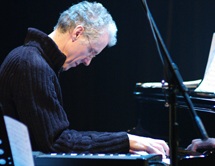 David
Binney, festival highlights were provided by especially
Sylvain Provost, whose irrepressible lyricism and inventive guitar
puts him at the very top of his game right now, and the no-frills
playing and composition of keyboardist Yves Léveillé.
David
Binney, festival highlights were provided by especially
Sylvain Provost, whose irrepressible lyricism and inventive guitar
puts him at the very top of his game right now, and the no-frills
playing and composition of keyboardist Yves Léveillé.
If David
Binney isn’t already the most compelling name is modern
jazz, he is surely a lesson on what modern jazz can (should) be.
Assuming big-bang leader JoeSullivan
and his army of maddening improvisors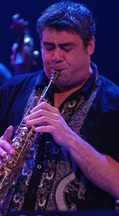 were in the audience (their attendance should have been compulsory),
they would have learned from Binney that the most important note
in the repertoire is silence, that making music has nothing to
do with trying to squeeze 64 1/32nd notes into a second, and that
when you treat melody like it’s virus, the entire score
(stripped of its human agency) rings false.
were in the audience (their attendance should have been compulsory),
they would have learned from Binney that the most important note
in the repertoire is silence, that making music has nothing to
do with trying to squeeze 64 1/32nd notes into a second, and that
when you treat melody like it’s virus, the entire score
(stripped of its human agency) rings false.
What
has been lost, or sacrificed on the alter of modernity among too
many jazz musicians is the sacred trust between soloist and audience.
When the soloist has something to say, what is said will have
a beginning, middle and end, a logical flow and directionality
that even the untrained ear cannot miss. A solo is not a permission
to indulge in primal therapy, blow off angst or revel in virtuosity.
If the admonition “you’re never too old to learn”
still holds, Joe Sullivan and his misdirected soloists are exhorted
to get back to basics, to that sacred inner flame from which all
authentic music issues. So if it’s a common complaint among
local jazz musicians that they’re not getting the notice
they deserve, it’s in part because audiences are not suckers
for composition and playing that masquerade as music.
To spend
an evening with David Binney is to sign
up for a journey that, like life itself at the end of the long
day’s night, is sure to break you down and beat you up along
the way, but at the same time, it promises to leave you stronger
and wiser. Making music and life intertwine is Binney’s
confession of what he’s all about as a human being, which
is what audiences connect to, the result of which would be significantly
diminished if it weren’t for the remarkable participation
of his fellow musicians. From Thomas Morgan on bass, we learn
that the bass solo need not be a ‘let’s get this over
with' interval. Minimalism in the visual arts might not be your
cup of tea, but Morgan makes his minimalist bass solos sing like
a lead instrument.
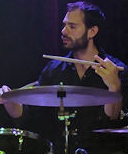 The
most arresting revelations of the evening were sculpted by gifted
percussionist Dan Weiss, who just might be one of the very best
in the world. In the spirit of Aldo Romano, conceptualist par
excellence, Weiss, on a dime, could change the entire dynamic
of the music without drawing attention to how and what he was
doing: at any given moment he might tap out a feeling using table
knives on the cymbal, or flutter his bare fingers over the drum
skin. From Dan Weiss we learn that there are no limitations to
what a drum kit can deliver once the necessity to produce a particular
sound or concept is recognized and embraced.
The
most arresting revelations of the evening were sculpted by gifted
percussionist Dan Weiss, who just might be one of the very best
in the world. In the spirit of Aldo Romano, conceptualist par
excellence, Weiss, on a dime, could change the entire dynamic
of the music without drawing attention to how and what he was
doing: at any given moment he might tap out a feeling using table
knives on the cymbal, or flutter his bare fingers over the drum
skin. From Dan Weiss we learn that there are no limitations to
what a drum kit can deliver once the necessity to produce a particular
sound or concept is recognized and embraced.
When
the concert ended, there was no call for an encore, such was the
satisfaction level generated by a series of remarkable compositions,
several of which are
featured in the CD Welcome To Life. As for the sublime
conclusion to the evening, it redounds to Binney’s highly
evolved relationship with his musicians that they are always encouraged
to engage as creative co-equals in the privileged undertaking
of making music.
Jazz
En Rafale, which translates into gusts of jazz, was just that
– music ushered in on the welcome winds of spring that spring
eternal.
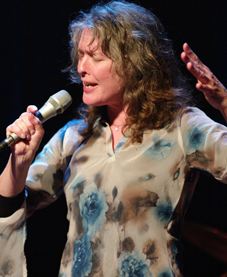
PHOTOS
© MARCEL DUBOIS